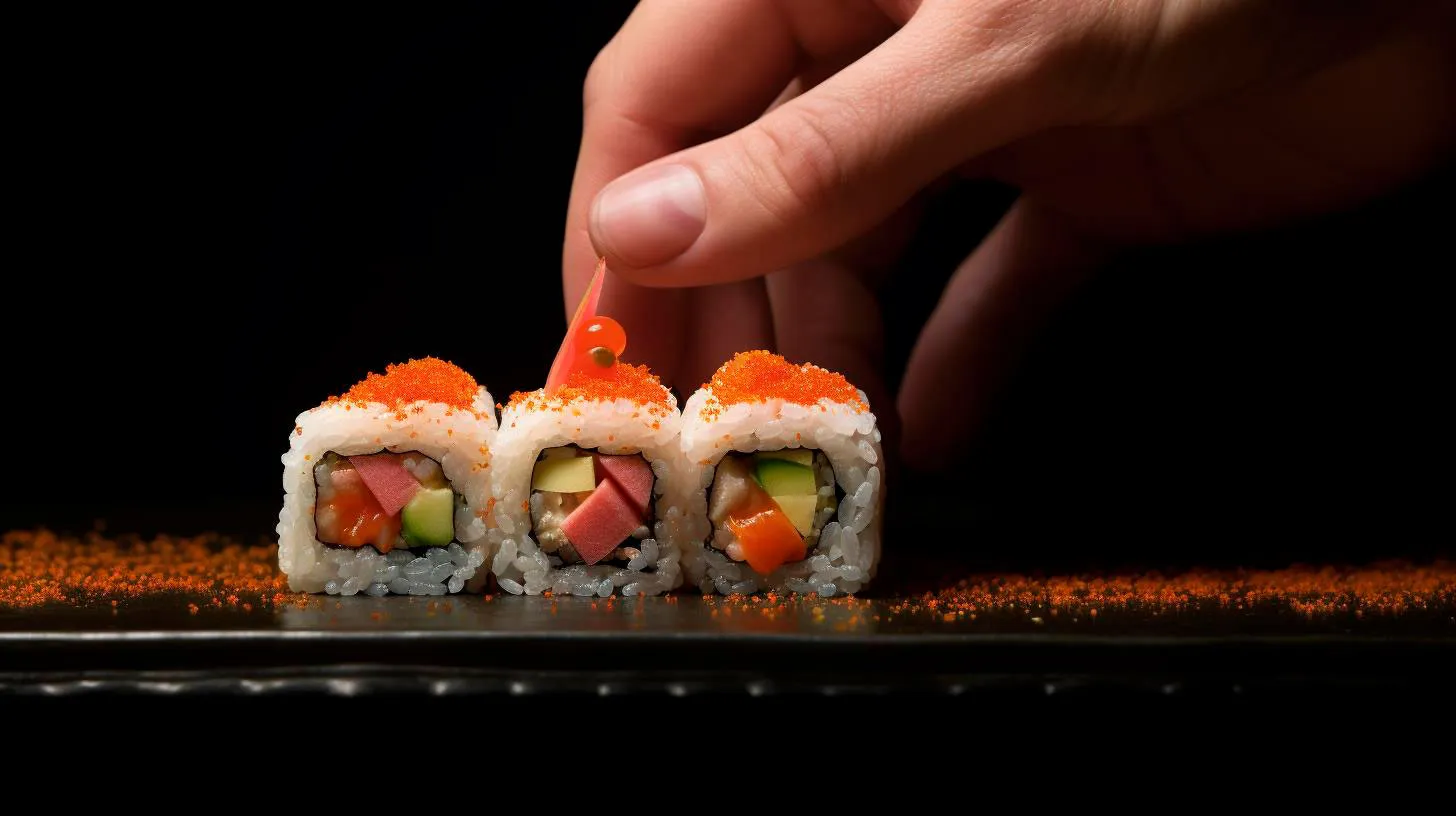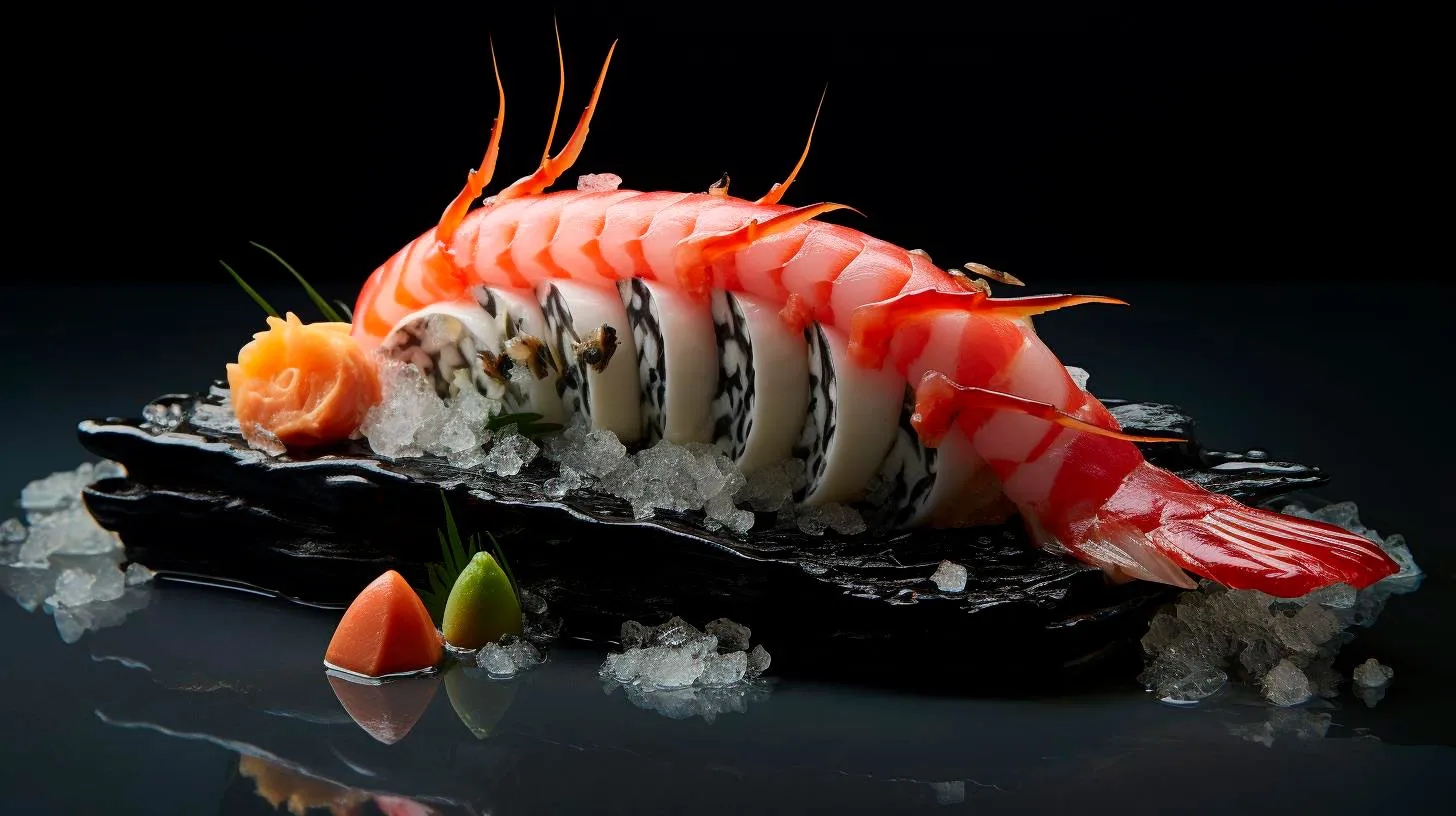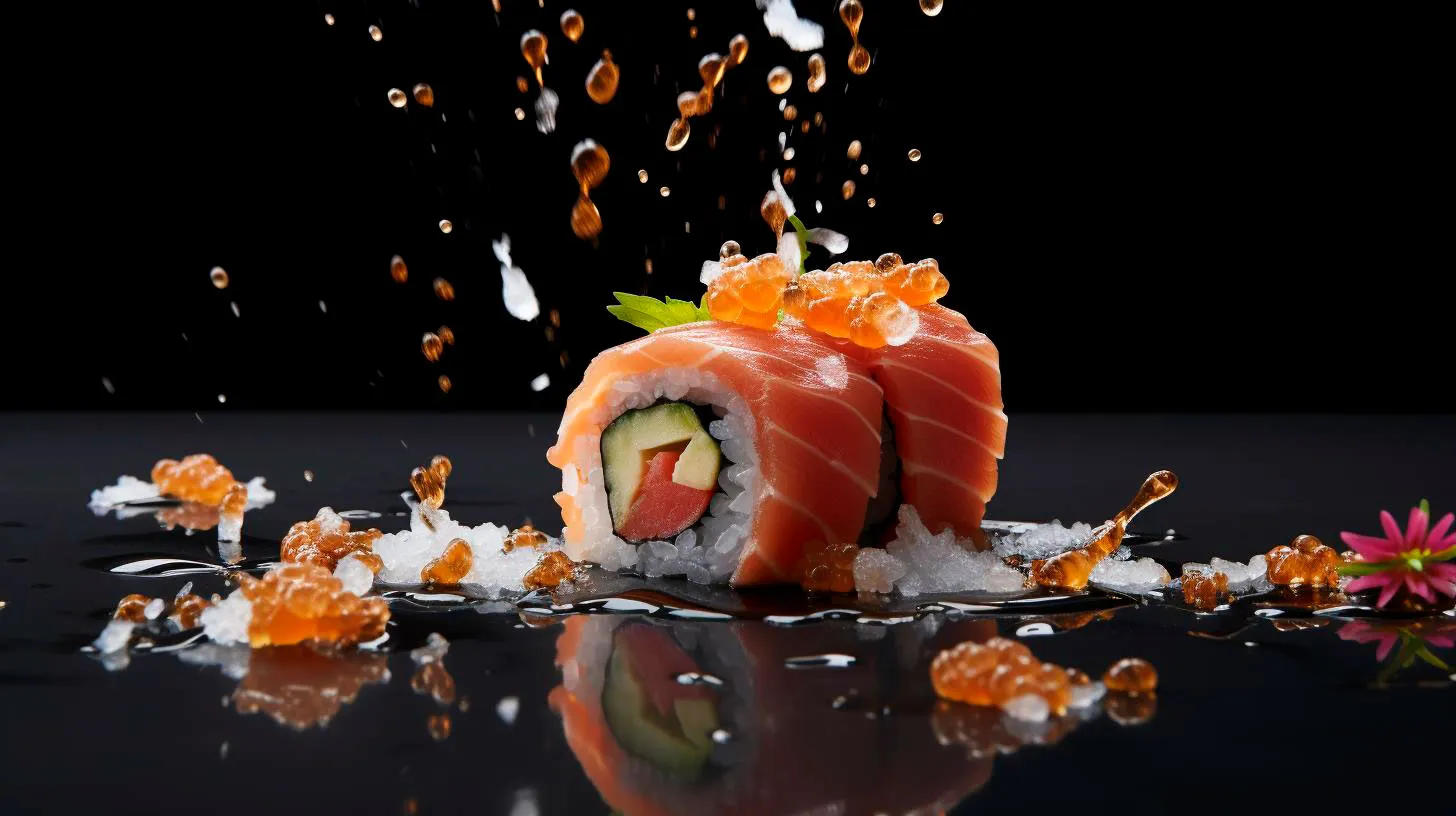Embracing the Exquisite Art of Sushi: Western Palates Crave More
Its delicate flavors, artistic presentation, and health benefits have made it a favorite among food enthusiasts, especially in the Western world. In this article, we will delve into the exquisite art of sushi, exploring why Western palates crave more of this delectable delicacy.
The Allure of Sushi
Sushi is not just a meal; it is an experience that tantalizes the senses. The artistry involved in crafting each piece of sushi is remarkable. From the precise slicing of fresh fish to the meticulous arrangement of ingredients, every element is carefully considered. The visually stunning presentation is a testament to the skill and passion of sushi chefs.
Furthermore, sushi offers a unique combination of flavors that provide a balanced culinary experience. The umami taste, often associated with savory and rich flavors, is prominent in sushi due to ingredients like soy sauce, miso, and seaweed. The combination of raw fish, vegetables, and rice delivers a gourmet symphony of tastes that leaves a lasting impression.
Sushi has also gained popularity due to its health benefits. It is a low-calorie and nutrient-rich meal option, providing essential vitamins, minerals, and omega-3 fatty acids. Additionally, sushi often incorporates raw fish, which is a good source of high-quality protein. These health-conscious factors have contributed to the increasing demand for sushi among health-conscious individuals.
Meeting Western Palates
Although sushi originated in Japan, it has evolved to suit the preferences of Western palates. The inclusion of ingredients like avocado, cream cheese, and spicy sauces has transformed traditional sushi into a fusion of flavors. Western-style sushi rolls, such as the California roll and the Philadelphia roll, have become popular choices for those seeking a unique twist on the classic dish.
Furthermore, sushi has adapted to accommodate dietary and cultural restrictions. Vegetarian and vegan sushi options have gained popularity, ensuring that individuals with specific dietary preferences can still indulge in this culinary delight. Sushi restaurants have also embraced gluten-free alternatives, allowing individuals with gluten sensitivities to enjoy sushi without concern.
Thanks to globalization, the availability of sushi has increased significantly in Western countries. Sushi bars and restaurants can now be found in almost every major city. According to a report by Statista, the global sushi market is estimated to reach a value of $22.6 billion by 2025, highlighting the growing demand for this Japanese delicacy.
The Benefits of Embracing Sushi
When it comes to sushi, there are several benefits that go beyond the pleasure of enjoying a unique culinary experience:
- Health Conscious Choice: Sushi is an excellent option for those looking to maintain a healthy lifestyle. The abundance of fresh ingredients, lean proteins, and omega-3 fatty acids make it a nutritious choice.
- Diverse Dining Option: Sushi offers a wide range of flavors, textures, and ingredient combinations, providing a diverse dining experience for even the most discerning palates.
- Cultural Appreciation: By embracing sushi, one can appreciate and celebrate the rich cultural heritage from which it originated. It serves as a gateway to understanding Japanese traditions and customs.
- Creative Expressiveness: Sushi represents the perfect marriage of culinary skills and artistic expression. It inspires creativity and encourages chefs to push the boundaries of flavor combinations and presentation.
- Community and Social Aspect: Enjoying sushi with friends or family fosters a sense of togetherness and community. The shared experience of trying different rolls and discussing flavors creates lasting memories.
The Crave for Sushi Continues
The ongoing popularity of sushi speaks volumes about its enduring appeal. As Western palates become more adventurous and open to new flavors, the demand for sushi continues to rise. It has established itself as a staple in many food enthusiasts’ diets, enticing them with its delicate flavors and captivating presentation.
So, the next time you find yourself craving something extraordinary, consider indulging in the exquisite art of sushi. Allow your senses to be delighted by the delicate symphony of flavors and textures that sushi has to offer. After all, embracing the extraordinary is what makes life truly delicious.
Sushi and Sashimi: A Delectable Journey from Japan to the West
In this article, we will take you on a delectable journey through the origins, types, and popularity of sushi and sashimi.
The Origins
The roots of sushi and sashimi can be traced back to ancient Japan. Sushi, the more well-known of the two, originated as a means of preserving fish. The fish was fermented with rice and salt, and the rice was discarded before consumption. As time went on, sushi evolved, with rice being served together with the fish, creating the sushi we know and love today.
Sashimi, on the other hand, is all about the fish. The word “sashimi” actually means “pierced flesh” in Japanese, referring to the traditional method of slicing the fish. Originally, sashimi was only consumed by the aristocracy due to its fresh and delicate nature. However, it eventually became popular among the masses.
Types of Sushi and Sashimi
There is a wide variety of sushi and sashimi available today. Let’s explore some of the most popular types:
Sushi:
- Nigiri: The most common type of sushi, consisting of a slice of raw fish placed on top of a small mound of rice.
- Maki: Sushi rolls wrapped in seaweed (nori) with various fillings such as fish, vegetables, or even fruit.
- Sashimi: Thinly sliced, raw fish or seafood served without rice.
- Chirashi: A bowl of sushi rice topped with an assortment of sashimi and other ingredients like pickled vegetables.
- Temaki: Also known as “hand rolls,” temaki is a cone-shaped sushi roll filled with a variety of ingredients.
Sashimi:
- Maguro: Bluefin tuna, known for its rich flavor and deep red color.
- Hamachi: Yellowtail, prized for its buttery texture and mild flavor.
- Sake: Fresh salmon, often marinated or smoked to enhance its taste.
- Uni: Sea urchin, a delicacy with a creamy and briny flavor.
- Ebi: Cooked shrimp, sweet and succulent.
Popularity in the West
Sushi and sashimi have gained tremendous popularity in the West over the past few decades. Once considered exotic and unfamiliar, they are now widely available and enjoyed by people from all walks of life. This can be attributed to several factors:
Health Benefits:
Sushi and sashimi are often seen as healthy options in Western diets due to their reliance on raw fish and seafood. They provide valuable nutrients, including omega-3 fatty acids and lean protein. According to a study by the American Heart Association, consuming fish rich in omega-3 fatty acids can help reduce the risk of heart disease by up to 36%.
Flavor and Variety:
The unique flavors and textures of sushi and sashimi have captivated the palates of food enthusiasts around the world. From the melt-in-your-mouth texture of toro (fatty tuna) to the vibrant flavors of fresh wasabi and soy sauce, each bite is a culinary adventure.
Social Media Influence:
The explosion of social media platforms has played a significant role in spreading the popularity of sushi and sashimi. Instagram users, in particular, have made these dishes iconic, showcasing them through captivating photos and videos. This has piqued the curiosity of foodies and inspired them to try sushi and sashimi for themselves.
Key Takeaways
- Sushi and sashimi originated in Japan and have a rich history dating back centuries.
- There are various types of sushi and sashimi, each with its own unique characteristics.
- Sushi and sashimi have become popular in the West due to their health benefits, flavorful taste, and social media influence.
- Consuming sushi and sashimi can provide valuable nutrients and reduce the risk of heart disease.
- The aesthetic appeal and variety of sushi and sashimi make them irresistible to food enthusiasts.
Next time you visit a Japanese restaurant or sushi bar, take a moment to appreciate the journey sushi and sashimi have made from their humble beginnings to becoming international sensations. Indulge in the flavors, textures, and history behind these delectable dishes, and let them transport you to Japan and beyond.
Sushi Revolution: How Japanese Cuisine Conquered Western Dining
In this article, we will delve into the fascinating story of how sushi has revolutionized the Western dining scene and explore the key factors driving its popularity.
The Rise of Sushi
Sushi’s journey from a regional delicacy to a global phenomenon is nothing short of extraordinary. Over the past few decades, Japanese cuisine as a whole has gained immense popularity, and sushi has played a pivotal role in this. Here’s a look at the factors that have contributed to the rise of sushi:
- Health Consciousness: With an increasing focus on healthier dining options, sushi’s low-fat and nutrient-rich ingredients have become highly appealing to health-conscious individuals.
- Globalization: As travel and globalization have bridged cultural gaps, people have become more adventurous in their culinary experiences, seeking out new and exotic flavors.
- Visual Appeal: Sushi’s colorful and artistic presentation, along with the mesmerizing skills of sushi chefs, has captured the attention of diners seeking visually appealing meals for their social media feeds.
- Unique Taste: Sushi’s combination of flavors, textures, and subtle umami notes provide a unique gastronomic experience that leaves a lasting impression.
- World-class Chefs: The expertise and craftsmanship of sushi chefs have elevated sushi to an art form. Their skillful techniques and meticulous attention to detail contribute to sushi’s allure and reputation for excellence.
Sushi’s Impact on Western Dining
Sushi’s popularity has had a profound impact on the Western dining scene, transforming the way people eat and perceive food. Let’s explore some significant changes driven by the sushi revolution:
- Diversification of Palates: Sushi has introduced Western diners to flavors and ingredients they may not have encountered before, expanding their culinary horizons and promoting diversity in Western diets.
- Healthier Eating Habits: Sushi’s focus on fresh ingredients, lean proteins, and portion control has inspired people to adopt healthier eating habits, leading to a positive impact on public health.
- Cultural Exchange: Sushi’s global popularity has fostered cultural exchange, providing a deeper understanding and appreciation of Japanese traditions and cuisine among Western societies.
- Restaurant Evolution: The success of sushi has prompted innovation and creativity within the restaurant industry. Sushi-centric establishments have emerged, adapting to Western tastes while still honoring the authenticity of the cuisine.
- Economic Growth: The demand for sushi has created numerous job opportunities within the food service industry, benefiting both small-scale sushi vendors and large-scale international chains.
Key Takeaways
The sushi revolution has undoubtedly changed the culinary landscape in Western countries. Here are the key takeaways from this cultural and gastronomic transformation:
- Sushi’s rise is fueled by health consciousness, globalization, and its visually appealing presentation.
- Sushi has influenced Western dining by diversifying palates, promoting healthier eating habits, and fostering cultural exchange.
- Restaurants have evolved to cater to the growing demand for sushi, leading to economic growth and job opportunities.
- Sushi’s journey from a regional delicacy to a global culinary sensation is a testament to the power of cultural exchange and the ever-evolving nature of food trends.
So, the next time you savor a piece of sushi, remember that you are partaking in a culinary revolution that has not only brought a taste of Japan to the West but also transformed the way we eat and appreciate food. Embrace the sushi revolution and indulge in the artistry and flavors it has to offer!
Exploring the Phenomenon Sushi and Sashimi Surge in Popularity
In this article, we will delve into the reasons behind the surge in popularity of sushi and sashimi, as well as uncover their unique characteristics that make them stand out in the culinary world.
The Appeal of Sushi and Sashimi
Sushi and sashimi are not just ordinary dishes; they intricately combine flavor, texture, and presentation to provide an unparalleled gastronomic experience. Here are some key reasons why these dishes have gained immense popularity:
- Health Benefits: Sushi and sashimi are packed with nutrients. Rich in omega-3 fatty acids, protein, vitamins, and minerals, they offer numerous health benefits, including improved heart health, boosted metabolism, and enhanced brain function.
- Freshness: The freshness of the ingredients used in sushi and sashimi is crucial. Whether it’s the fish, vegetables, or even the rice, the quality and freshness add a distinct taste to these dishes.
- Varied Options: Sushi and sashimi offer a wide range of options to suit different palates. From classic favorites like salmon and tuna to more adventurous choices like sea urchin and eel, there is something to satisfy everyone’s taste buds.
- Visual Appeal: The artful presentation of sushi and sashimi is visually enticing. The vibrant colors, delicate garnishes, and meticulous arrangement create an aesthetic experience that entices both the eyes and the palate.
The Rise of Sushi and Sashimi in Popularity
Over the past few decades, sushi and sashimi have experienced an unprecedented surge in popularity worldwide. There are several factors contributing to this phenomenon:
- Increased Awareness of Japanese Cuisine: With the globalization of food culture, Japanese cuisine has gained significant recognition and appreciation. People are seeking authentic global flavors, and sushi and sashimi have become synonymous with Japanese culinary excellence.
- Health Consciousness: As people become more health-conscious, the demand for fresh, nutritious, and low-calorie options has risen. Sushi and sashimi perfectly fit into this trend, offering a light yet satisfying meal choice.
- Adventurous Palates: Modern food enthusiasts love exploring unique and exotic flavors. Sushi and sashimi, with their distinctive taste profiles and unusual ingredients, provide an adventurous culinary experience.
- Social Media Influence: The rise of social media has significantly contributed to the popularity of sushi and sashimi. Instagrammable food trends and visually appealing dishes have caught the attention of food lovers worldwide, elevating the status of these Japanese delicacies.
Key Takeaways
Sushi and sashimi have captured the hearts and palates of people around the world due to their exceptional blend of flavors, health benefits, and aesthetic appeal. The surge in popularity can be attributed to various factors, such as increased awareness of Japanese cuisine, health consciousness, adventurous tastes, and the influence of social media. Now, let’s summarize the key takeaways:
- Sushi and sashimi offer numerous health benefits with their rich nutritional composition.
- The freshness and quality of ingredients contribute significantly to the unique taste of these dishes.
- The wide variety of options caters to different preferences.
- The artful presentation enhances the overall dining experience.
- Japanese cuisine, including sushi and sashimi, has gained global recognition and appreciation.
- Sushi and sashimi align with the current trend of seeking adventurous and exotic flavors.
- Social media has played a vital role in amplifying the popularity of these dishes.
As the world becomes more connected, the popularity of sushi and sashimi continues to grow. Whether you are a seasoned sushi aficionado or a curious food enthusiast, these Japanese delicacies will undoubtedly leave you craving for more.



